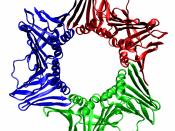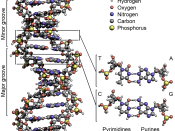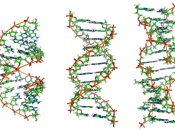Every living thing is made up of cells. Every cell has a nucleus, and in every nucleus has chromosomes. Human beings have 46 chromosomes or 23 chromosome pairs and each chromosome contains hundreds of genes. These genes contain the recipes, for proteins that make up most of the body. Structural proteins form things such as skin, hair, and muscle. These chromosomes are very long compact coils of DNA (DeoxyriboNuclic Acid) that store all the information that the body needs such as how one looks and functions.
DNA is a thread formed by two strands, wound together to form a Double Helix. The Double Helix looks like a twisted ladder. The "sides" of this "ladder" are long units called nucleotides and are made up of three parts; a nitrogenous base, a sugar, and a phosphate group. The sides of the ladder or the nucleotides from the two separate strands of the DNA are attached by an appendage made up of one of four separate bases.
These appendages represent the "rungs" of the DNA "ladder" and are attached to the complimentary strand or side of the DNA. The bases or "rungs" are made up of either Adenine (A) and Thymine (T) or Cytosine (C) and Guanine (G). The attachment of the strands by the bases is specific as Adenine can only join with Thymine, and Cytosine can only join with Guanine. Since this base pairing is specific, if one knows the sequence of bases along one strand of the DNA one will also know the sequence along the complimentary strand.
DNA as a Basis for InheritanceThe unique pairing of the rungs of the DNA ladder is the basis for DNA acting as the molecule of inheritance. DNA duplicates in a process called DNA replication. This process involves the separating of a DNA...



Well done
covered most fields quite well, and information was really understandable, even for someone like my self
0 out of 0 people found this comment useful.